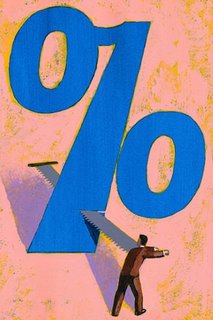As expected, The Federal Open Market Committee (
FOMC) of The Federal Reserve Board has just voted to raise The Federal Funds Rate by 25 basis points (0.25 percentage points) to 4.5%. This means that the de facto Wall Street Journal Prime Rate (the U.S. Prime Rate) is now
7.5%. Many American banks have already released statements announcing that their prime lending rate is now
7.5%, including:
- The Bank of America*
- The Bank of New York*
- Wells Fargo*
- Wachovia*
- KeyCorp*
- SunTrust*
- Colonial Bank*
- Sky Financial Group*
Today's rate increase comes as no surprise to economists, bankers and rate watchers, as most have been predicting a quarter point increase from The Fed today. Today's Fed Funds Rate increase-- and subsequent prime rate increase--is the 14
th straight bump to these key banking interest rates, and it looks like more rate increases are coming as the year progresses.
Prime Rate PredictionsAccording to the latest economic data, the economy is doing well, and if the economy continues to do well, then another rate increase is likely, as The Fed will try to cool things down in an effort to stave-off inflation. The Fed is also keenly interested in attaining what's called the "neutral rate" for the Federal Funds Rate: the neutral rate can be described as a Fed Funds Rate that neither encourages nor curtails U.S. economic growth. Most economist believe that with the current Fed Funds Rate of 4.5%, we aren't quite @ "neutral" yet, so at least one more 0.25 percentage point increase should be expected.
The majority of economists who responded to a recent poll are predicting that The Fed Funds Rate will be bumped up to 4.75% by the end of June, 2006, and that it will remain @ 4.75 for the rest of 2006. Since the prime rate can be expressed as:
then, according to the latest predictions, the WSJ Prime Rate should hit 7.75% by mid-summer and stay @ 7.75% for the rest of the year.
A minority of the folks who deal in government securities that are associated with The Fed are predicting that The Fed will raise The Fed Funds Rate to 5% by the end of 2006.
Of course, there are many, continually shifting variables that have an effect on The Fed's interest rate strategy, foremost being inflation, but there are also many other important measures of the U.S. economy that The Fed watches closely. And let's not forget that a new Fed Chairman taking is over tomorrow--so prime rate predictions should always be viewed with a skeptical eye.
Alan Greenspan Exits As Ben Bernanke Is Confirmed As The New Fed ChairmanAlan Greenspan leaves his post as Fed Chairman today as a banking celebrity (there are even rock songs that invoke his name!) and it's no surprise if you think about it.
The economy is cyclical, so there will always be periods of economic growth, followed by periods of economic sluggishness, then growth again, and so on ad infinitum. As Chairman of The Federal Reserve Board, Dr. Greenspan was in charge of U.S. monetary policy during America's longest sustained economic expansion of the postwar period, and that is nothing to sneeze at. Greenspan should be proud of his accomplishments--no doubt--but we should also keep the other side of the coin in mind: how much credit can we bestow on Greenspan when in fact his only real power was controlling banking interest rates? Was the expansion of the 90's a bad thing, since e.g. many of those billion-dollar-burn-rate, dotcom companies ended up going nowhere? Did Greenspan & Co. set interest rates too low, creating a massive real estate bubble that will end up hurting American consumers in the long term? Did low interest rates help to turn Americans into borrow-crazy consumers with little or no savings?
I personally think that Alan Greenspan did a good job, especially the way he handled the country's banking situation after the 911 attacks. To put things into perspective,
check out the way interest rates were going in the early 80's before Greenspan took over:
not a pretty picture! The way I see it, Greenspan could have done much worse, and that is the bottom line.
Greenspan will now go back to economic consulting, which is what he was doing before going into public service; the latest (unconfirmed) buzz is that Greenspan's new consulting firm will be called Greenspan Associates. I think it's safe to write that, as a consultant, Greenspan will charge whatever he wants for his services, and he'll get it.
Ben Bernanke was confirmed to take over as The Fed Chairman today, and I wish him well; officially,
Bernanke will take the helm tomorrow morning. Bernanke steps up to the plate with excellent credentials so I doubt that Americans have anything to worry about. Many would rather just clone Greenspan and give the facsimile two terms as Fed chief; just nervousness about a new face, that's all.
The next
FOMC
meeting--which will be the first with Ben Bernanke calling the
shots--will take place on March 28, 2006, and, as of right now, most
experts are predicting another 0.25 percentage point increase to The
Fed Funds Rate (which would translate to a 0.25 percentage point increase
to the WSJ Prime Rate.) Stay tuned to
The
Prime Rate Blog as I'll be posting the latest buzz about prime
rate predictions between now and the end of March.
Here's a snippet from today's
press release issued by The Fed:
"The Federal Open Market Committee decided today to raise its target for the federal funds rate by 25 basis points to 4-1/2 percent.
Although recent economic data have been uneven, the expansion in economic activity appears solid. Core inflation has stayed relatively low in recent months and longer-term inflation expectations remain contained. Nevertheless, possible increases in resource utilization as well as elevated energy prices have the potential to add to inflation pressures.
The Committee judges that some further policy firming may be needed to keep the risks to the attainment of both sustainable economic growth and price stability roughly in balance. In any event, the Committee will respond to changes in economic prospects as needed to foster these objectives.
Voting for the FOMC monetary policy action were: Alan Greenspan, Chairman; Timothy F. Geithner, Vice Chairman; Susan S. Bies; Roger W. Ferguson, Jr.; Jack Guynn; Donald L. Kohn; Jeffrey M. Lacker; Mark W. Olson; Sandra Pianalto; and Janet L. Yellen."
Labels: fomc, prime_rate_forecast, prime_rate_increase
 The Federal Open Market Committee (FOMC) of the Federal Reserve has just adjourned its seventh scheduled monetary policy meeting of 2008, and, in accordance with the latest forecast, has just lowered its target for the Federal Funds Rate by 50 basis points (0.50 percentage point) to 1.00%. Therefore, as of today, the U.S. Prime Rate is now 4.00%.
The Federal Open Market Committee (FOMC) of the Federal Reserve has just adjourned its seventh scheduled monetary policy meeting of 2008, and, in accordance with the latest forecast, has just lowered its target for the Federal Funds Rate by 50 basis points (0.50 percentage point) to 1.00%. Therefore, as of today, the U.S. Prime Rate is now 4.00%.


